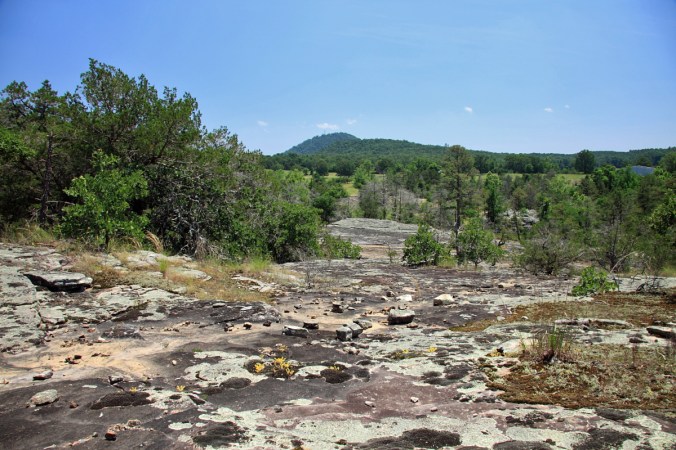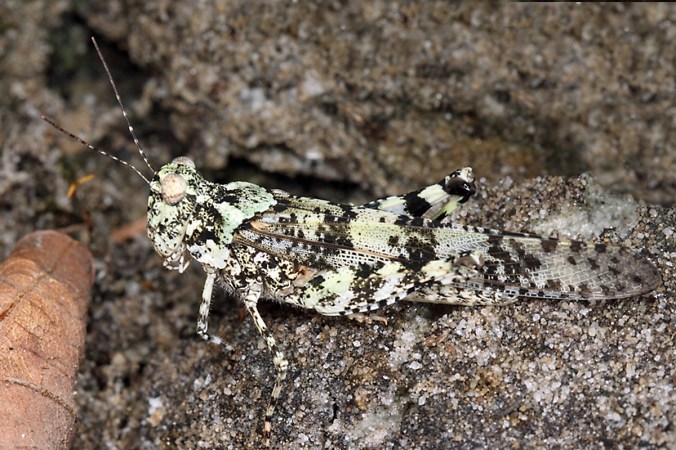Ever since my current fascination with band-winged grasshoppers (family Acrididae, subfamily Oedipodinae) began, I have been obsessed with photographing one species above all others—Trimerotropis saxatilis, the lichen grasshopper. Like most species in the group, lichen grasshoppers utilize an interesting survival strategy that I call “conspicuous crypsis”—the use of stunning colors and contrasting markings to help them blend into the mottled and variably-colored environments that they inhabit. Lichen grasshoppers take this strategy to the extreme, culminating in some individuals with the most gorgeous shade of blue-green in perfect match to the crustose lichens that cover the rock outcroppings of their preferred glade habitats. In my opinion, they are the kings of the oedipodines! I have seen them before in past years in the igneous and sandstone glades that dot the Ozark Highlands of southern Missouri. Crustose lichens abound in these acid environments, providing the perfect backdrop to make invisible these otherwise conspicuous grasshoppers. This past June during a couple of visits to a marvelous sandstone glade complex near Calico Rock in north-central Arkansas I got my wish, and shown here are some of my favorites from the many, many photographs I took during those sessions.
Lichen grasshoppers are actually quite variably colored—not all individuals exhibit the green coloration for which they are so famous. Despite this, they are the only member of the genus occurring in the eastern U.S. and, thus, are immediately recognizable. While they are beautiful in all of their color variations, I cannot lie—it is the green individuals that I constantly find myself admiring the most. While many other grasshoppers are green, only a handful (themselves members of the same subfamily) exhibit the same stunning shade of blue-green that this one does. Add to that an abundance of black speckling and contrasting bands, and you’ve got one gorgeous grasshopper. Yet, for all their overt beauty, they are absolutely impossible to see in their native habitat until they take flight when approached. Fortunately, their escape flights are short and not terribly erratic—with a little practice it becomes rather easy to track them in flight (aided by their interrupted buzzing crepitation) and watch where they land. They may not be immediately visible after landing, but with careful study of the landing area they are usually quickly relocated. Once detected, slow deliberate movements are all that are needed to allow a close approach and a good look (and photographs if desired).
Of course, the problem with ‘conspicuous crypsis’ (or any form of crypsis, for that matter) is that it only works when in the right environment. I chased the above lichen-colored individual onto this patch of dark moss while trying to photograph it, at which point it became overtly visible.
As previously mentioned, lichen grasshoppers come in a variety of colors and shades. While the green individuals may be the most stunning, I was captivated also by the below individual, darker brown and black, with the most beautiful, contrastingly colored orange eyes. This individual may not blend in as well as the green individuals when sitting on lichen-encrusted rocks; however, its coloration and patterning seem perfectly adapted to the more barren, darkly colored rock exposures. This helps explain why not all lichen grasshoppers are green—the rock exposures in the glades that they inhabit are not uniformly lichen-encrusted, but rather consist of both encrusted and barren expanses of rock, with diverse coloration being a result of multiple and sometimes conflicting selective pressures.
A third individual, shown in the photograph below, resembles the second in that it is more brown than green. However, the base coloration is lighter with greater contrast to the dark bands. Like the second individual the eyes are spectacular orange, but it also exhibits a green shading on the back of the head behind the eyes not seen in the second individual.
Not only did I find the adults, but I also found a rather young nymph that certainly represents this species (I’m guessing maybe 3rd instar based on the degree of wing pad development). This nymph exhibits the same stunning green coloration that the first individual above shows, and its fortuitous occurrence on both lichen-encrusted and (relatively) barren rocks provide an excellent demonstration of the effectiveness of its coloration in achieving crypsis—now you see me…
…now you don’t!
Copyright © Ted C. MacRae 2011








Great looking little hoppers!
Long live the king!
Ah, the glades at Calico Rock. It’s a great spot for collared lizards, too. Just watch out for the local constabulary!
What’s up with local law enforcement?
Years ago, a friend and I were collecting plants for a study and we stopped near this spot to record an interesting frog we had heard there the week before. Long story short: the plants and digging implements were spotted in the truck by a Sherrif’s deputy who suspected we were up to something. Once the identity of the plants was known, i.e., once they were shown not to be a certain illicit herb, the whole thing was cleared up without too much fuss. Ah, the memories.
Great story! I haven’t had any problems so far – perhpas the big tiger beetle emblazoned on the front of my t-shirt serves to ease suspicions about what I might be up to.
Wow, very nicely done. After last summer’s Invertebrates in Education and Conservation conference I came away with a new appreciation for so many of the orthopterans. Stunning images. Excellent post, Ted!
Thank you, Dave. Orthops are cool, and oedipodines rock!
Fascinating grasshoppers and your photographs are superb. The camouflage coloration raises some interesting questions.
Thanks, Roberta – I appreciate the kind remark.
Cool documentation of the interesting color variation of this beastie.
When I was in Arizona last summer, I encountered another beautiful member of this genus, that charmed me.
http://bugguide.net/node/view/145305/bgimage
Yes, out west all bets are off – there are a number of cool species in this genus and other oedipodine genera.
wow, amazing nymph, can you imagine the thousands of years of evolution to get to that point. Amazing find, that is like finding a needle in a haystack.
Invisible when sitting still, but their movement gives them away to this observant entomologist!
Pingback: More on ‘Conspicuous Crypsis’ « Beetles In The Bush
Oedipodinae is my favourite acridid subfamily! Great shots Ted.
Thanks, Sam – nice to hear from you.
Incidentally, Leuronotina ritensis (Arphiini) are also remarkable lichen mimics. Have you ever seen this species?
Is that the one out in Arizona? I remember seeing a blog post about it a couple years ago (Doug Taron at Gossamer Tapestry) and thinking how remarkably similar to T. saxatilis it is. Next time I’m out there I hope to see it.
I was in these same glades near Calico Rock two weeks ago! Talk about hot! We also saw a lichen grasshopper, but did not get close enough to photograph one. Your photos are excellent and record one of my favorite invertebrates, the lichen grasshopper! Nice job Ted!
Hi Henry – nice to hear from you. It looks like we missed each other by just a week or so. I made two trips, one in early June and the other in late June, and the temperatures reached the mid-upper 90s both times! Not even those hellish conditions, however, were going to stop me from getting photos of this spectacular grasshopper.
Hi, I was recommended by friends to look at your post. I agree with them, very well written. Amazing finds. Thank you for all the useful information.
Hi Bob. Thanks for the visit – glad you liked it.
Pingback: Lined Jewel Beetle « Beetles In The Bush
Pingback: Ozark Landscapes – White River in northern Arkansas « Beetles In The Bush